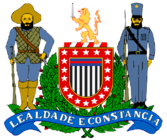Military Police of São Paulo State
|
Military Police of Sao Paulo State Polícia Militar do Estado de São Paulo |
|
|---|---|
| Abbreviation | PMESP |

Badge of the Military Police of Sao Paulo State
|
|
| Motto | Loyalty and Constancy Lealdade e Constância |
| Agency overview | |
| Formed | December 15, 1831 |
| Legal personality | Governmental: Government agency |
| Jurisdictional structure | |
| Operations jurisdiction* | State of São Paulo, [[]] |
 |
|
| Map of police jurisdiction. | |
| Size | 248,209.426 km2 (95,834.195 sq mi) |
| Population | 41,055,734 (2006) |
| General nature | |
| Operational structure | |
| Headquarters | São Paulo |
| Website | |
| Official website | |
| Footnotes | |
| * Divisional agency: Division of the country, over which the agency has usual operational jurisdiction. | |
The Polícia Militar do Estado de São Paulo (São Paulo State Military Police) is a law enforcement agency (Polícia Militar) of the military kind in the state of São Paulo, Brazil. It is the largest state police force in the country, with over 100,000 personnel in its ranks, distributed across several battalions all over the state as well as within the Greater São Paulo region (Grande São Paulo) which itself comprises 40 cities and towns.
Under the United Nations, in cooperation with the Brazilian Army, the Military Police of São Paulo State has served in Angola, Mozambique, East-Timor, Sudan, and Haiti.
Its primary function is to perform the patrolling of public places such as city streets, state highways and forests in the entire state and also authority escorting, intelligence and reconnaissance (P2) and crime prevention duties. São Paulo Fire Fighters belongs to PMESP and are equally structured as a state police organization.
The PMESP is further divided into specialized units as follows:
The police force was founded by Brigadier General Rafael Tobias de Aguiar on December 15, 1831, originally as the São Paulo Municipal Imperial Guard. The MPSP of today was raised in 1935 as a result of its involvement in the Constitutionalist Revolution of 1932.
Conte Lopes, now a political representative, was a commanding officer (ranked as captain) behind the famous ROTA units in the 1970s and 1980s.
Cel. Ubiratan Guimarães, the commanding officer of the police operation resulting in the Carandiru massacre, was a high-ranked officer in the PMESP ranks (ranked as colonel).
...
Wikipedia
